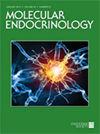研究资源:激素、基因和运动能力:雄激素对禽类肌肉转录组的影响。
Q Biochemistry, Genetics and Molecular Biology
引用次数: 42
摘要
雄性脊椎动物的社会表现从简单到复杂,后者涉及对身体和附属物的精细运动指挥。对这些表现的研究反过来又为神经运动机制提供了实质性的见解。新热带金领侏儒鸟(Manacus vitellinus)以前被用作研究复杂运动技能的模型,因为该物种的成年雄性表现出杂技式的雄激素依赖性求爱表现。为了支持这种行为,这些鸟在骨骼肌中表达高水平的雄激素受体(AR)。在这里,我们使用RNA测序来探索睾酮(T)如何调节肌肉转录组来支持雄性侏儒的求偶表现。此外,我们探讨了雄激素如何影响斑胸草雀(Taenopygia guttata)肌肉中的基因表达,斑胸草雀是一种具有有限求偶表现和最小肌肉AR的雀形鸟模型。我们在这两个物种中都发现了雄激素依赖的、肌肉特异性的基因调控。此外,我们还确定了与侏儒动物展示过程中肌肉使用相关的侏儒动物特异性效应,包括与肌纤维收缩性、细胞稳态和能量效率相关的基因的雄激素调节。总的来说,我们的研究结果表明,雄激素影响了雄性鸟类的许多基因和基因网络,包括一些在表演杂技表演所需的最佳肌肉功能的基础。Manakins是探索促进运动能力的基因调控的优秀模型。本文章由计算机程序翻译,如有差异,请以英文原文为准。
Research Resource: Hormones, Genes, and Athleticism: Effect of Androgens on the Avian Muscular Transcriptome.
Male vertebrate social displays vary from physically simple to complex, with the latter involving exquisite motor command of the body and appendages. Studies of these displays have, in turn, provided substantial insight into neuromotor mechanisms. The neotropical golden-collared manakin (Manacus vitellinus) has been used previously as a model to investigate intricate motor skills because adult males of this species perform an acrobatic and androgen-dependent courtship display. To support this behavior, these birds express elevated levels of androgen receptors (AR) in their skeletal muscles. Here we use RNA sequencing to explore how testosterone (T) modulates the muscular transcriptome to support male manakin courtship displays. In addition, we explore how androgens influence gene expression in the muscles of the zebra finch (Taenopygia guttata), a model passerine bird with a limited courtship display and minimal muscle AR. We identify androgen-dependent, muscle-specific gene regulation in both species. In addition, we identify manakin-specific effects that are linked to muscle use during the manakin display, including androgenic regulation of genes associated with muscle fiber contractility, cellular homeostasis, and energetic efficiency. Overall, our results point to numerous genes and gene networks impacted by androgens in male birds, including some that underlie optimal muscle function necessary for performing acrobatic display routines. Manakins are excellent models to explore gene regulation promoting athletic ability.
求助全文
通过发布文献求助,成功后即可免费获取论文全文。
去求助
来源期刊

Molecular endocrinology
医学-内分泌学与代谢
CiteScore
3.49
自引率
0.00%
发文量
0
审稿时长
12 months
期刊介绍:
Molecular Endocrinology provides a forum for papers devoted to describing molecular mechanisms by which hormones and related compounds regulate function. It has quickly achieved a reputation as a high visibility journal with very rapid communication of cutting edge science: the average turnaround time is 28 days from manuscript receipt to first decision, and accepted manuscripts are published online within a week through Rapid Electronic Publication. In the 2008 Journal Citation Report, Molecular Endocrinology is ranked 16th out of 93 journals in the Endocrinology and Metabolism category, with an Impact Factor of 5.389.
 求助内容:
求助内容: 应助结果提醒方式:
应助结果提醒方式:


